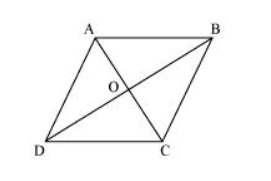Show that if the diagonals of a quadrilateral bisect each other at right angles, then it is a rhombus.
Solution:

Let $A B C D$ be a quadrilateral, whose diagonals $A C$ and $B D$ bisect each other at right angle i.e., $O A=O C, O B=O D$, and $\angle A O B=\angle B O C=$ $\angle C O D=\angle A O D=90^{\circ} .$ To prove $A B C D$ a rhombus, we have to prove $A B C D$ is a parallelogram and all the sides of $A B C D$ are equal.
In $\triangle \mathrm{AOD}$ and $\triangle C O D$,
$O A=O C$ (Diagonals bisect each other)
$\angle \mathrm{AOD}=\angle \mathrm{COD}$ (Given)
OD = OD (Common)
$\therefore \triangle \mathrm{AOD} \cong \triangle \mathrm{COD}($ By $S A S$ congruence rule $)$
$\therefore A D=C D(1)$
Similarly, it can be proved that
$\mathrm{AD}=\mathrm{AB}$ and $\mathrm{CD}=\mathrm{BC}(2)$
From equations (1) and (2),
$A B=B C=C D=A D$
Since opposite sides of quadrilateral $A B C D$ are equal, it can be said that $A B C D$ is a parallelogram. Since all sides of a parallelogram $A B C D$ are equal, it can be said that $A B C D$ is a rhombus.

Let $A B C D$ be a quadrilateral, whose diagonals $A C$ and $B D$ bisect each other at right angle i.e., $O A=O C, O B=O D$, and $\angle A O B=\angle B O C=$ $\angle C O D=\angle A O D=90^{\circ} .$ To prove $A B C D$ a rhombus, we have to prove $A B C D$ is a parallelogram and all the sides of $A B C D$ are equal.
In $\triangle \mathrm{AOD}$ and $\triangle C O D$,
$O A=O C$ (Diagonals bisect each other)
$\angle \mathrm{AOD}=\angle \mathrm{COD}$ (Given)
OD = OD (Common)
$\therefore \triangle \mathrm{AOD} \cong \triangle \mathrm{COD}($ By $S A S$ congruence rule $)$
$\therefore A D=C D(1)$
Similarly, it can be proved that
$\mathrm{AD}=\mathrm{AB}$ and $\mathrm{CD}=\mathrm{BC}(2)$
From equations (1) and (2),
$A B=B C=C D=A D$
Since opposite sides of quadrilateral $A B C D$ are equal, it can be said that $A B C D$ is a parallelogram. Since all sides of a parallelogram $A B C D$ are equal, it can be said that $A B C D$ is a rhombus.
